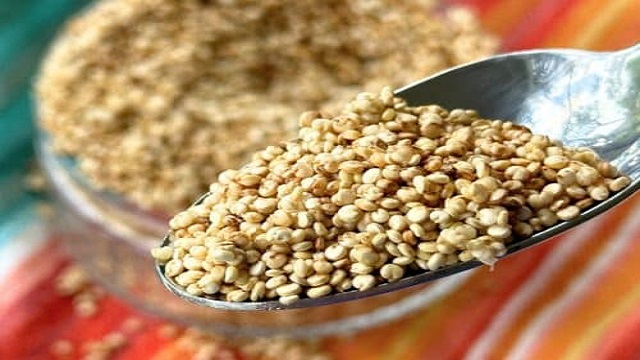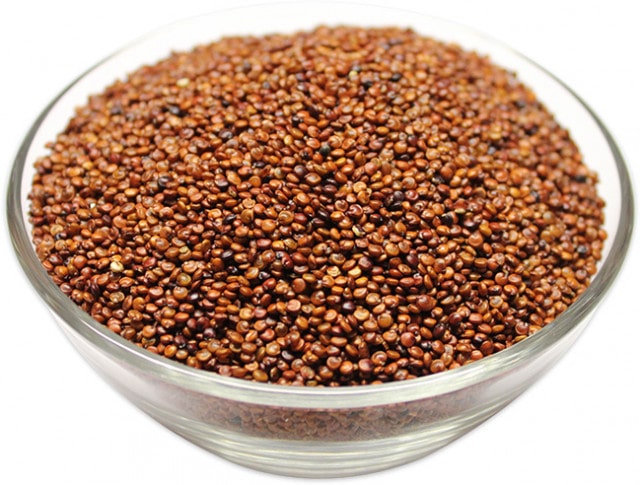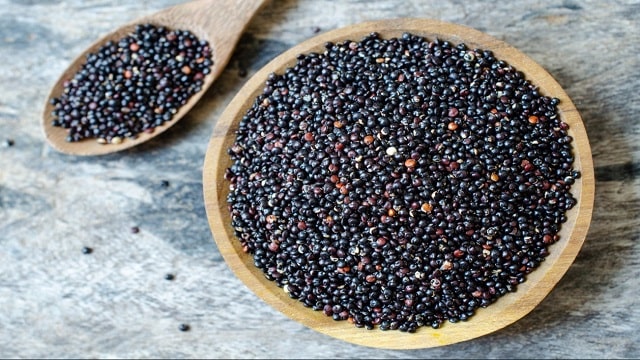Quinoa is a seed native to the Andes that can be cooked like rice. It is rich in protein, fiber and healthy fats and is gluten-free. It delights us in salads or accompanied by vegetables and chicken and helps reduce cholesterol. Today, everything about quinoa: types, properties and uses.
Originally from the Andes and cultivated for millennia, quinoa is a nutritious pseudocereal full of benefits. It is rich in protein, fiber, and healthy fats, which makes it ideal to include in dinner, either accompanied by vegetables or converted into the base of our pizza. Among its virtues are helping to lower cholesterol and reduce stress. And today, many nutritionists include it as a healthy option in weight loss diets. Below, we delve into the origin of quinoa, its properties, its high nutritional value, and all the recipes with which to enjoy it.
What is quinoa?
Quinoa, also known as quinoa or quinoa ( Chenopodium quinoa ) is a seed with extraordinary properties that we can cook and consume as if it were a cereal. Its name comes from the Quechua term kinwa. It is suitable for celiacs because it does not contain gluten and is as easy to prepare as couscous or rice. It differs from other cereals due to its high protein content and healthy omega-6 and omega-3 fats.
The flavour of quinoa is particularly mild, so once cooked it invites you to combine it with all kinds of foods: quinoa with vegetables, quinoa with chicken, or quinoa with chickpeas and broccoli… When cooking it, we can play with the texture, and even bake it to get crunchy quinoa and add it to our salads or yogurt. Nowadays, it is so accessible that we can find it in most large supermarkets, as well as buying quinoa in bulk in herbalists and specialist shops.
The plant is highly appreciated for its rapid growth, genetic flexibility, and climate adaptability. So much so that although its optimum development point is around 20 °C, it can grow equally well in hot desert areas or rainy and cold areas in temperature ranges from -8 °C to 38 °C. Harvesting takes place in just four or five months. The herbaceous part is used for animal feed and the seeds are sold worldwide. All of this makes quinoa a nutritious and profitable crop.
According to the FAO, Bolivia, Peru and Ecuador were the largest producers until 2010. And due to the boom in consumption, today we can find crops in France, England and Sweden, as well as in Kenya, India and the United States. However, Peru remains the world’s largest exporter.
Origin and history of quinoa
Quinoa is native to the Andes, where indigenous people have been cultivating and protecting it for millennia. In the Lake Titicaca basin between Bolivia and Peru, pre-Hispanic cultures were already cultivating quinoa 3,000 years ago. Not only that but at the beginning of the last century, German archaeologist Max Uhle claimed that this seed was already domesticated in the region of present-day Ayacucho 5,000 years ago.
Its encounter with the Hispanic world is recorded in 1551 when Pedro de Valdivia, the conquistador, mentions its presence in some letters to Spain. From that moment on, the plant that was once considered sacred by the Incas would suffer worse fate. The Spanish were unable to transport it to the peninsula without it perishing on the long journeys by boat and according to the work of Mario Tapia, the similarity of quinoa to bledas made it worthy of more than one scorn. In this regard, other sources claim that the low appreciation had more to do with its un-Christian uses and consumption, which is why the conquistadors would have destroyed entire plantations.
Today, quinoa is grown in more than 70 countries. It is considered a superfood and the FAO celebrated it throughout 2013 by speaking of its virtues and its potential as an economical and nutritious food to feed the entire world population.
Types of quinoa
Although white quinoa is the most well-known, there are other types of seeds. In fact, there are at least 300 varieties that we could consume. To simplify things, we will focus on the main categories: white quinoa, red quinoa, and black quinoa. Although there are also orange or purple ones, this classification allows us to know the main differences in terms of flavor, uses, and nutritional contribution of the types of quinoa that we can find in our daily lives.
White quinoa

White quinoa is the most well-known and accessible seed. It can be found in supermarkets, markets, and bulk stores. Among the varieties included in this category, the royal quinoa qanchis stands out, with a lower caloric intake and high protein content. It is ideal for complementing vegan and vegetarian diets. And it is rich in fiber and minerals.
It takes no more than 15–20 minutes to cook in one and a half portions of water. It is commonly used in recipes that originally used rice, and a crispy version can be obtained by baking it for about 35 minutes at 180 °C.
Red quinoa

Red quinoa is equally nutritious with a good protein content, although it contains less healthy fats and a higher percentage of carbohydrates than white quinoa. It is especially recommended for athletes who require a high caloric intake and high amounts of protein.
What sets red quinoa apart from other varieties is its betalain content, and phenolic compounds with a high antioxidant potential. This component is responsible for its color and gives it the power to reduce free radicals related to cell aging.
In the kitchen, it can be used in a similar way to white quinoa as long as we keep in mind that the cooking time is approximately 30 minutes.
Black quinoa

If red quinoa stood out for its betalain content, black quinoa does so for its anthocyanin content. This pigment responsible for its black color is present in other foods such as blueberries, cherries, or beets and has great antioxidant potential, helping to strengthen the cardiovascular system and protect against diseases caused by viruses. In addition, black quinoa contains lithium, a component that helps reduce stress and prevent depression.
Cooking time is about 30-35 minutes. It has a more earthy flavour and, like wild rice, has a crunchy texture. This variety is somewhat less accessible, although it is often present on the shelves of specialist shops.
Nutritional value of quinoa vs rice
The nutritional value of quinoa is exceptional. It is one of the few foods of plant origin that has all the essential amino acids, those that our body is unable to synthesize and that we could not obtain in any other way beyond food. It contains healthy fats, minerals and depending on the variety it can be especially rich in antioxidants. Its caloric intake is high compared to other foods such as vegetables but it is within the range of calories that would be expected for other cereals and seeds. It does not contain gluten although it does contain more minerals than, for example, rice, which can be seen in the comparative nutritional table of 100 g of quinoa vs 100 g of rice.
| Quinoa | Rice | |
| Energy value (kcal) | 368 | 340 |
| Carbohydrates (g) | 64.20 | 75 |
| Proteins (g) | 14,10 | 10.7 |
| Lipids (g) | 6.07 | 2 |
| Fiber (g) | 7 | 8 |
| Calcium (g) | 57 | 10 |
| Iron (g) | 5 | 0.5 |
| Magnesium (g) | 197 | 13 |
| Phosphorus (g) | 457 | 100 |
| Potassium (g) | 563 | 110 |
| Zinc (g) | 3 | 0.2 |
| Manganese (g) | 2 | 0 |
When we compare quinoa and rice, we find that the seed has a higher amount of protein and healthy fats. On the other hand, quinoa contains a higher concentration of calcium, iron, magnesium, phosphorus, potassium, and zinc than rice. They are not that different in the amount of amino acids, although quinoa has a high concentration of lysine, an amino acid not present in rice. Due to the characteristics of both, they are foods that can be complemented to ensure a complete protein intake.
Properties and benefits of quinoa
What is quinoa good for? When we first discovered it, we delved into all its culinary potential. Little by little, we discovered that it is not only a very healthy couscous but also an ingredient that helps us take care of our cardiovascular health, our digestive system and even our mood.
Recommended for weight loss
If you have started a weight loss diet in recent years, it is very likely that your nutritionist has included quinoa in your plan at least once a week. The reason is that, although it is a high-calorie food, its fiber, protein, and mineral content makes it a complete, nutritious, and very filling ingredient. For this reason, consuming quinoa in moderate quantities is associated with healthy weight loss.
It does not contain lactose or gluten and is rich in protein.
Quinoa is a kind of ideal dish that allows us to invite a celiac friend, a vegetarian, and a lactose-intolerant friend to the same dinner. It does not contain gluten, it is of vegetable origin, and although it goes without saying that it is the seed of a herbaceous plant, it also does not contain lactose or of course milk protein. It combines wonderfully with vegetables, tofu, and nuts and is also rich in protein, and has all the essential amino acids. It is without a doubt an ally of the vegetarian diet and of possible intolerances.
Lowers cholesterol and takes care of the cardiovascular system
Quinoa does not contain cholesterol, but it does contain polyunsaturated fats associated with lowering triglyceride levels, preventing arrhythmias, and delaying the buildup of cholesterol plaque. This contribution of unsaturated lipids and fiber regulates blood cholesterol levels, improves the lipid profile and contributes to better cardiovascular health.
Reduces stress and improves mood
Quinoa contains amino acids related to emotional well-being, such as tryptophan and tyrosine . It also contains magnesium, which produces a general state of relaxation and reduces stress. If we choose black quinoa, it contains lithium, an active ingredient considered a natural antidepressant.
It has antioxidant and anti-aging effects.
All varieties of quinoa contain phenolic compounds, such as flavonoids and saponins, with antioxidant activity that helps keep the body young. Red quinoa and black quinoa stand out for their composition rich in betalain and anthocyanin, two very active antioxidants that help reduce free radicals and keep the body’s cells young for longer.
Contraindications of quinoa
Sometimes the saponin coating of quinoa can cause allergies or certain digestive problems. According to nutritionist Clara Muñoz from Bellvitge Hospital, a good preventive measure is to soak it before cooking to reduce the amount of saponin and phytates that cause this discomfort. Beyond this possible precaution and awareness of its caloric content, quinoa is a healthy ingredient in its many facts.
Recipes with quinoa and its uses in the kitchen
The first step to enjoying quinoa is to learn how to cook it . Once we have mastered the ideal proportions to obtain al dente and non-muddy quinoa, we can prepare quinoa for dinner or lunch in an infinite number of fresh and delicious combinations with quinoa recipes .
It is common to reserve a space for it in the so-called Poke or Buddha Bowl, along with a good portion of vegetables and proteins, such as marinated tofu. Another option is to add quinoa to a salad made with apples, walnuts, pepper, and carrots. Or try the excellent recipe for quinoa with vegetables and chicken. Less well-known is the juicy version of quinoa baked with cheese and the refreshing recipe for quinoa tabbouleh. Those who do not have an easily scandalized Italian nearby can dare to prepare a pizza with a quinoa base and corn flour.
And that’s not all, in the morning we can accompany our breakfast with quinoa milk or add puffed quinoa to our bowl of fruit and yogurt. At any time of the day, including quinoa can be a fantastic idea.